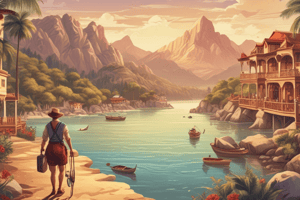Podcast
Questions and Answers
According to the Tourism Area Life Cycle (TALC) model, what is the primary purpose of this model as envisioned by Professor Butler?
According to the Tourism Area Life Cycle (TALC) model, what is the primary purpose of this model as envisioned by Professor Butler?
- To promote uncontrolled tourism growth to maximize short-term profits for local businesses.
- To offer a retrospective analysis of how tourism areas have evolved historically.
- To assist developers in proactive planning and to explore alternative development strategies for tourism areas. (correct)
- To provide a framework for managing tourism destinations exclusively during periods of decline and stagnation.
In the initial 'Exploration' stage of the Tourism Area Life Cycle (TALC), what main characteristics define a destination?
In the initial 'Exploration' stage of the Tourism Area Life Cycle (TALC), what main characteristics define a destination?
- A few visitors are drawn to the area’s natural attractions, pristine environments, and unique culture. (correct)
- The local government imposes strict regulations to limit tourism and preserve the environment.
- Large numbers of tourists arrive, leading to overcrowding and environmental stress.
- Massive infrastructure development, including large resorts and international airports.
During the 'Involvement' stage of the Tourism Area Life Cycle (TALC), what marks the beginning of tourism development?
During the 'Involvement' stage of the Tourism Area Life Cycle (TALC), what marks the beginning of tourism development?
- The destination becomes highly dependent on tourism such that the local economy suffers from economic leakage.
- The local community and foreign investors begin to invest in tourism-related infrastructure and services. (correct)
- Strict governmental regulations are enforced to displace foreign investment and retain local autonomy.
- A sharp decline in tourist arrivals due to negative publicity.
In the 'Development' stage of the Tourism Area Life Cycle (TALC), what changes typically occur regarding the number of tourists compared to the local population?
In the 'Development' stage of the Tourism Area Life Cycle (TALC), what changes typically occur regarding the number of tourists compared to the local population?
How is the 'Consolidation' stage defined within the Tourism Area Life Cycle (TALC)?
How is the 'Consolidation' stage defined within the Tourism Area Life Cycle (TALC)?
What are the primary indicators of the 'Stagnation' stage in the Tourism Area Life Cycle (TALC)?
What are the primary indicators of the 'Stagnation' stage in the Tourism Area Life Cycle (TALC)?
According to the Tourism Area Life Cycle (TALC), what signifies the beginning of the 'Decline' stage in a tourism destination?
According to the Tourism Area Life Cycle (TALC), what signifies the beginning of the 'Decline' stage in a tourism destination?
In the context of the Tourism Area Life Cycle (TALC), what critical factors determine whether a destination will experience 'Rejuvenation' versus 'Decline'?
In the context of the Tourism Area Life Cycle (TALC), what critical factors determine whether a destination will experience 'Rejuvenation' versus 'Decline'?
What is typically the initial reaction of local residents as a tourist area enters the 'Development' phase, according to the Tourism Area Life Cycle (TALC)?
What is typically the initial reaction of local residents as a tourist area enters the 'Development' phase, according to the Tourism Area Life Cycle (TALC)?
Which of the following scenarios best illustrates the 'Stagnation' stage in Butler's Tourism Area Life Cycle (TALC)?
Which of the following scenarios best illustrates the 'Stagnation' stage in Butler's Tourism Area Life Cycle (TALC)?
During the 'Consolidation' stage of the Tourism Area Life Cycle (TALC), which factor most significantly impacts the local economy of a tourism destination?
During the 'Consolidation' stage of the Tourism Area Life Cycle (TALC), which factor most significantly impacts the local economy of a tourism destination?
What actions might a tourism destination take during the 'Decline' stage of the Tourism Area Life Cycle (TALC) to promote 'Rejuvenation'?
What actions might a tourism destination take during the 'Decline' stage of the Tourism Area Life Cycle (TALC) to promote 'Rejuvenation'?
Which of the following scenarios represents a destination in the 'Exploration' stage of the Tourism Area Life Cycle (TALC)?
Which of the following scenarios represents a destination in the 'Exploration' stage of the Tourism Area Life Cycle (TALC)?
What infrastructure developments often characterize the 'Development' stage of the Tourism Area Life Cycle (TALC)?
What infrastructure developments often characterize the 'Development' stage of the Tourism Area Life Cycle (TALC)?
How does globalization relate the consolidation phase?
How does globalization relate the consolidation phase?
Which event will cause the most rapid decline in tourism?
Which event will cause the most rapid decline in tourism?
What happens to the capacity when decline hits?
What happens to the capacity when decline hits?
Complete rejuvenation can include which of the following?
Complete rejuvenation can include which of the following?
The first phase of the TALC includes which of the following?
The first phase of the TALC includes which of the following?
What year did Professor Butler come up with the TALC model?
What year did Professor Butler come up with the TALC model?
Flashcards
TALC Model
TALC Model
A model by Professor Butler in 1980 that outlines the stages a tourism area goes through.
Exploration Stage
Exploration Stage
The first stage of the TALC model; few tourists are attracted by natural attractions.
Involvement Stage
Involvement Stage
The second stage in the TALC Model wherein tourism planning starts.
Development Stage
Development Stage
Signup and view all the flashcards
Consolidation Stage
Consolidation Stage
Signup and view all the flashcards
Stagnation Stage
Stagnation Stage
Signup and view all the flashcards
Decline in Tourism
Decline in Tourism
Signup and view all the flashcards
Rejuvenation Stage
Rejuvenation Stage
Signup and view all the flashcards
TALC Objective
TALC Objective
Signup and view all the flashcards
Economic Leakage
Economic Leakage
Signup and view all the flashcards
Overtourism
Overtourism
Signup and view all the flashcards
Study Notes
Tourism Area Life Cycle (TALC)
-
Tourism is a major global industry that is constantly evolving
-
Tourist attractions are vulnerable and need careful management
-
The sustainability of destinations relates to the carrying capacity
-
Professor Richard Butler's work on TALC is popular
-
Butler created the TALC model in 1980
-
This model is designed to guide developers in contingency planning and provide alternative ways
Exploration Stage
-
This marks the initial phase of the tourism cycle
-
The destination attracts visitors with natural beauty and unique culture
-
Government and locals begin to recognize opportunities within the tourism sector
-
Tourism planning commences
Involvement Stage
- This marks the start of tourism development
- Guest houses begin opening to accommodate visitors
- Foreign investors express interest in developing the area
- Government might experience strain to improve transportation infrastructure
Development Stage
- This phase involves extensive planning and construction
- New infrastructure, such as roads, trains, airports and terminals, gets constructed
- New tourist attractions emerge.
- Increased marketing and promotion of the destination happens
- Tourist population starts to outnumber the local population. Local control becomes reduced.
Consolidation Stage
- Tourism growth starts slowing during this stage
- Destinations become heavily dependent on tourism as main income source
- Globalization, leading to economic leakage, has a negative impact on the economy
- It becomes a negative social impact when local people become discontent
Stagnation Stage
- This represents the start of a decline in tourism
- Tourist numbers have peaked with varying capacities being met
- Destinations begin to lose their appeal
- There is a negative impact because of overtourism
- Which is causing potential economic, environmental and social consequences
Decline or Rejuvenation Stage
-
This stage represents several outcomes for destinations either rejuvenation or decline
-
Outcomes depend on plans and actions of stakeholders involved
-
Complete rejuvenation can occur via major developments, the addition of new attractions, sustainable approaches and change in the target market.
-
Without such changes, tourism may continue to decline at a slower pace
-
Rapid decline may occur because of war, natural disaster or a pandemic
Studying That Suits You
Use AI to generate personalized quizzes and flashcards to suit your learning preferences.




